Smooth-billed Anis formerly bred in Loxahatchee but have been absent for about 15 years. This pair of anis were first located about three weeks previously and their nest was subsequently discovered near the Marsh Trail observation tower in the largest of the two trees to the right of this photo (click on photos for larger size and additional images):
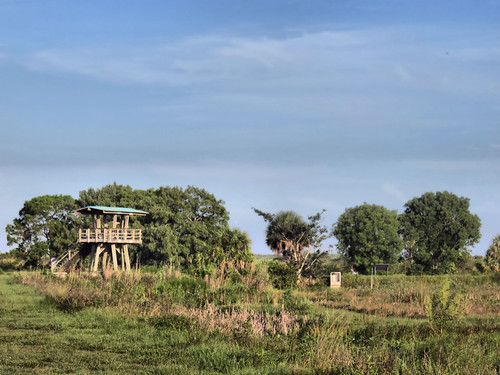
We were immediately rewarded with great views of one member of the pair. The other was sometimes visible through the foliage and is presumably incubating.
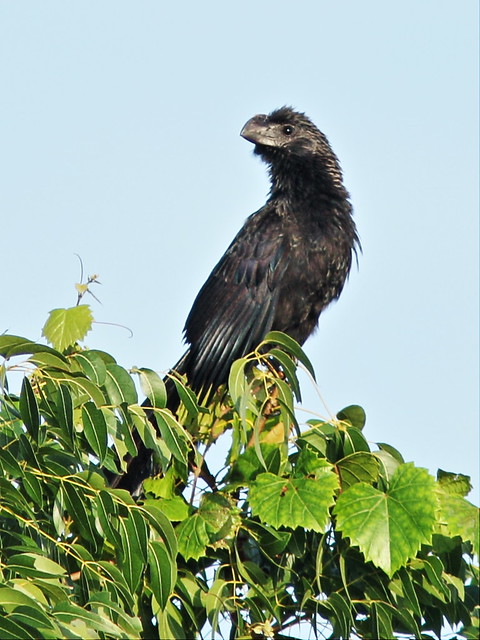
The ani is classified as a member of the cuckoo (Cuculidae) family. Its closest relative is the Hoatzin. Like the latter, the ani is normally a cooperative breeder, with several families sharing a nest and helping raise the young. Indeed, more than one female has been known to lay eggs in a nest as it is being built. The dominant female often will bury the eggs of those deposited earlier, incorporating them into the nest structure and assuring that they will not hatch.
The ani's large bill is most interesting, as it is arched and parrot-like. Overall it looks like a large blackbird (14.5 inches/37 centimeters), about the length of our Boat-tailed Grackle. Its long tail hangs down and appears to be loosely attached and its wings are short and broad.
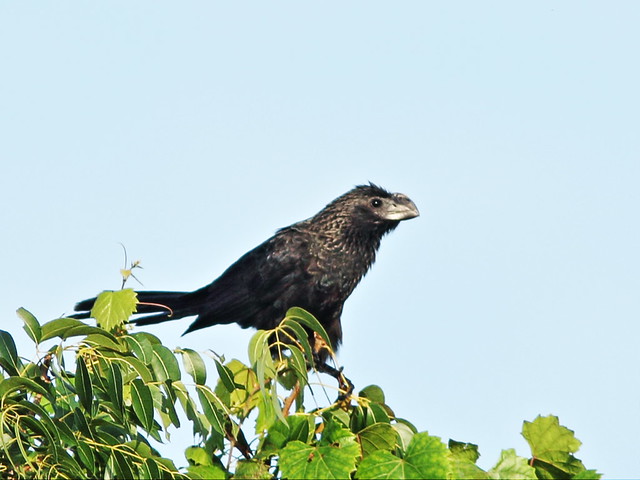
Bill detail:
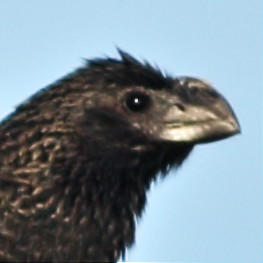
Residents of south Florida and the Caribbean, they were much more abundant locally about 30-40 years ago. Severe winters in the 1970s and habitat loss due to development are partly blamed for their reduced numbers. Now they are found in the USA almost exclusively in southern Florida, in scattered locations in the Florida Keys and along the coasts of the Gulf of Mexico, the Atlantic Ocean and Lake Okeechobee. They feed primarily on insects and small lizards and frogs, but also eat fruit, especially during the dry season. They typically nest at the beginning of the rainy season (summer, here in Florida) when insects are most abundant.
We did not stay very long as we had afternoon obligations, but had time to look for threatened Snail Kites, including this one with color-coded leg bands placed by researchers. This species depends heavily upon declining numbers of Apple Snails, but is adapting to another large exotic snail that is displacing the native species.
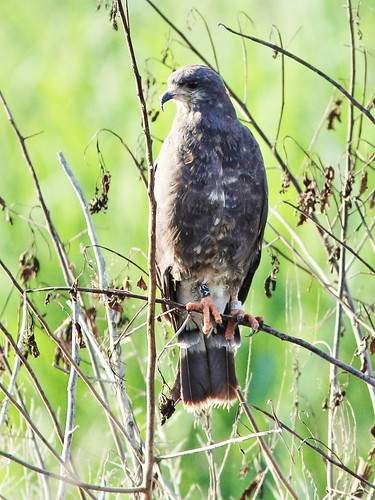
The Snail Kit's narrow and sharply curved bill is specialized for extracting the flesh from the snails:

This Little Blue Heron is transitioning from its first-year white to the adult plumage that gives it its name:
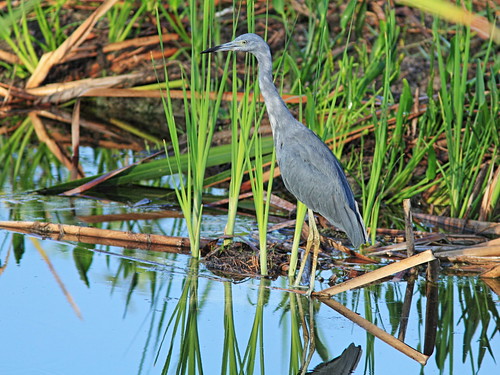
Wood Storks and a Great Blue Heron roosted in treetops along the trail. The two young storks have fuzzy heads and lighter bills than the adults:
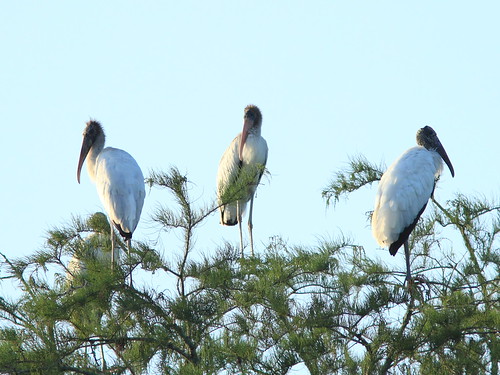
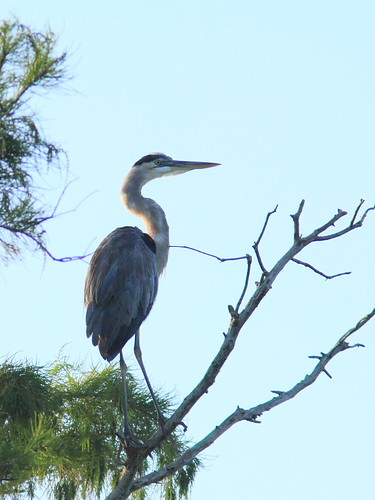
Black-necked Stilts and Glossy Ibises foraged in a flooded agricultural field near the entrance of the Refuge:
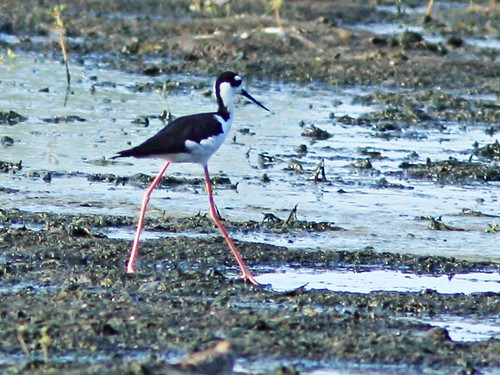
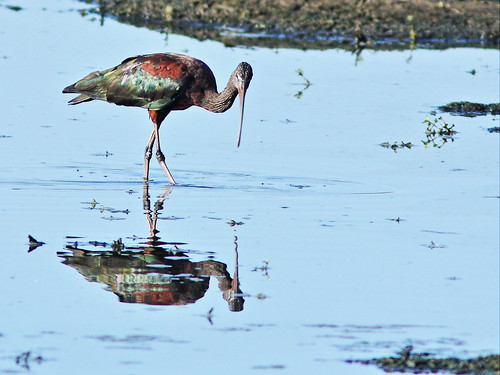
A Passion Flower attracted a Honeybee:
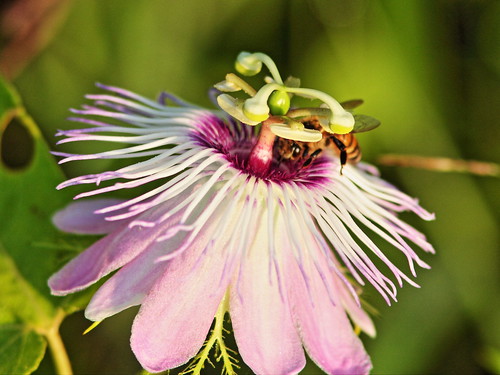
We proceeded to Green Cay wetlands, a waste water treatment area that is a great birding "hotspot."
The 1.5 miles (2.4 kilometers) of boardwalk are well-maintained:
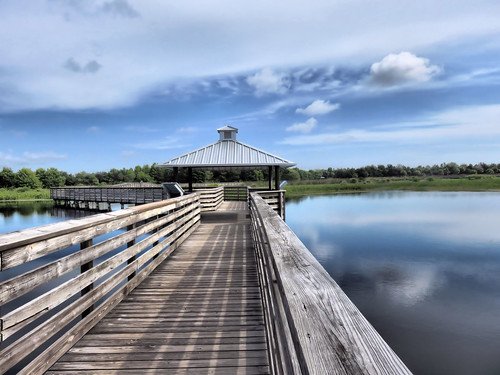
That's Mary Lou in the blue shirt, well in front of me (as usual):
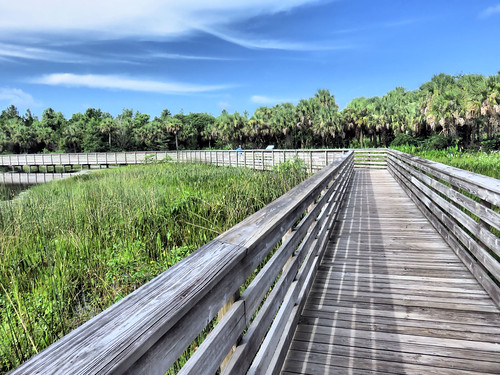
Purple Gallinules were particularly abundant, both adults...
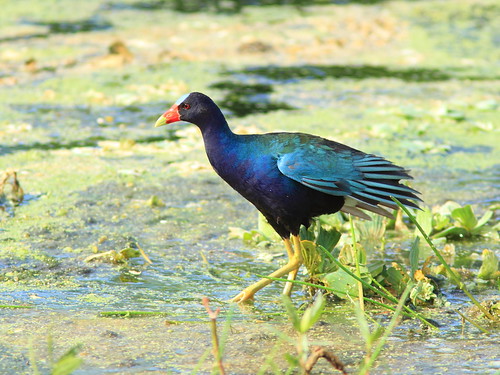
...and immature birds:
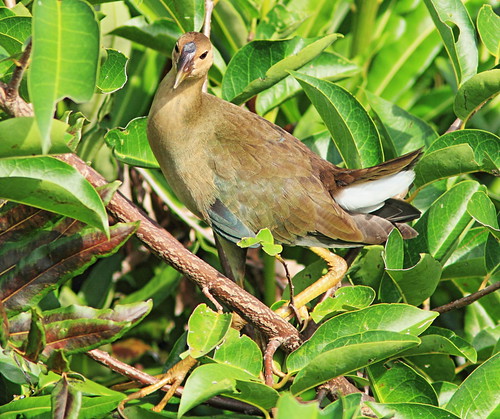
A Snowy Egret pranced on golden slippers in the mud flats:

Green Herons foraged patiently, ...
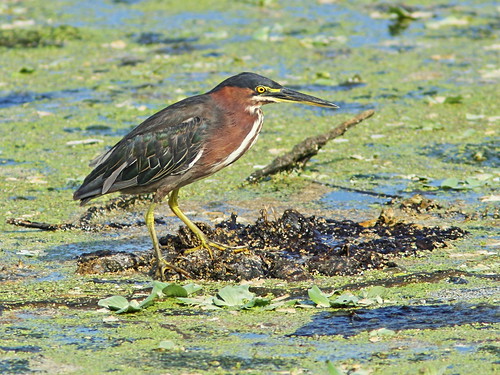
... and Anhingas dried their wings and preened:
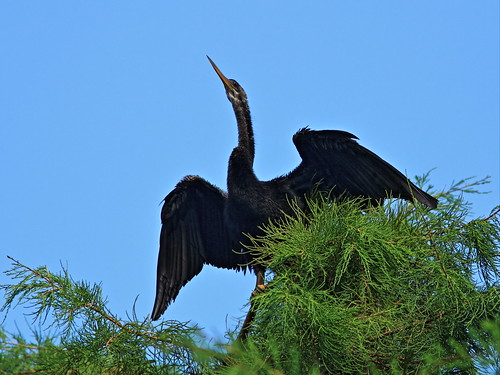
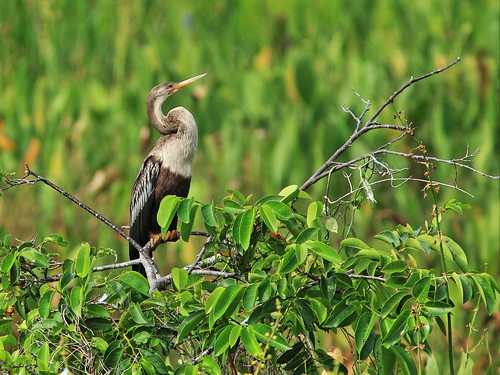
Striking red native Swamp Hibiscus bloomed along the boardwalk, ...
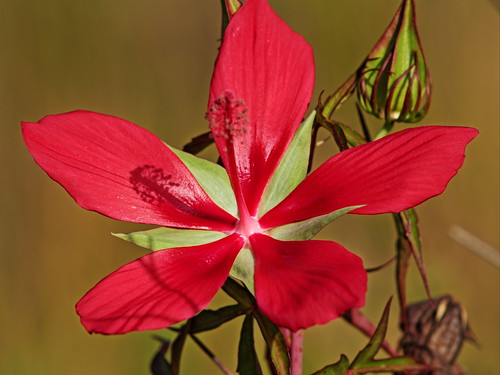
...contrasting with white Marsh Lilies..
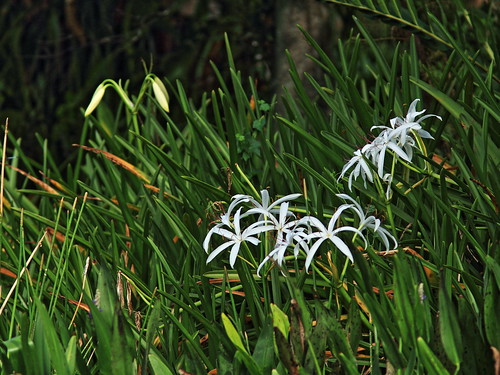
...and purple flowers of Pickerel-weed:
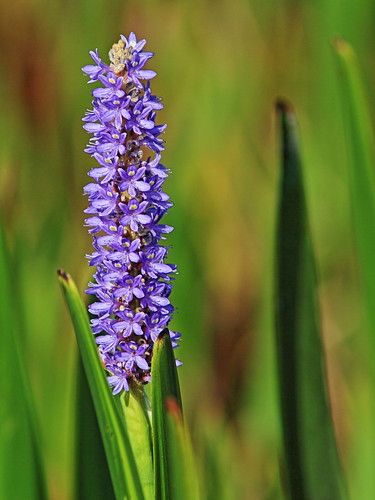
A Tricolored Heron posed so nicely that I was inspired to render it in HDR images by creating and layering different exposures from single RAW photos (I used this technique for the landscapes included in this post):

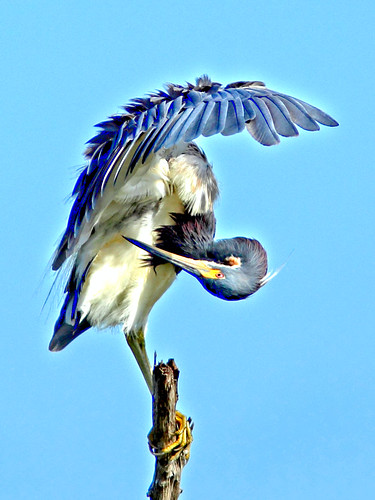
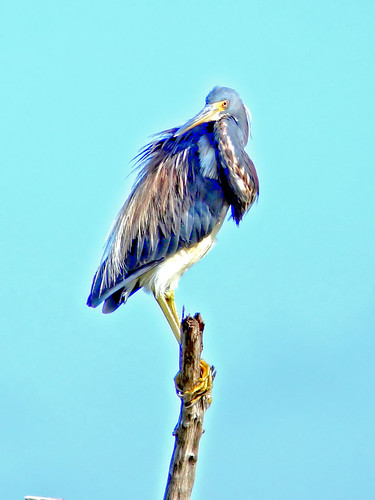
It was only mid-morning, but thunderheads loomed to the south over the Nature Center when we departed. We arrived home in the rain:
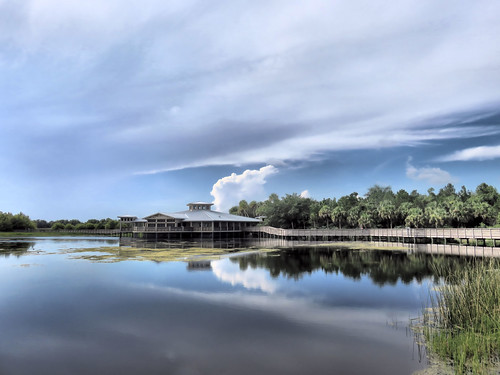
= = = = = = = = = = = = = = =
Linking to Misty's CAMERA CRITTERS,
Linking to Eileen's SATURDAY'S CRITTERS,
Linking to GOOD FENCES by Tex (Theresa).
Linking to WEEKEND REFLECTIONS by James
Linking to BirdD'Pot by Anni
Linking to Wild Bird Wednesday by Stewart
Linking to I Heart Macro by Laura
________________________________________________
Please visit the links to all these memes to see some excellent photos on display
Hello Ken, great collection of birds and images. I love the Ani and the Snail Kite. Cool birds. Your flowers and sky shots are beautiful too. Have a happy day!
ReplyDeleteunique bills on those first two birds! loved all your shots. beautiful boardwalk, beautiful blooms, beautiful reflections, too. thanks for linking!
ReplyDeleteGolly, I love all the photos, but I think the tricolored are my favorites!!
ReplyDeleteTruly awesome photos. Those boardwalks are magnificent!
ReplyDeleteI had never heard of some of these...specially that first. All so interesting. And I really love your photos.
ReplyDeleteWell you certainly got the best part of the day adnit was fantastic tht you go to see the Ani and also to show us the photos. well as usual all your bird adn flowers photographs are wonderful adn that is a fabulous board walk. The last shot is idyllic with the beautiful reflections in the water.
ReplyDeleteHi Kenneth me again.
ReplyDeleteJust to let you know that I will be on BBC Radio Ulster this Sunday 2 August between 2.00pm -3.00pm in a programme called “Time of our Lives”. I recorded it yesterday. If you miss it on Sunday, you can hear it on IPlayer Radio at http://www.bbc.co.uk/programmes/b06447zw
If you wish to hear my Irish voice!
What a great preserve with so many different bird species. I like your landscape shots, too.
ReplyDeleteWow, those tricolored heron shots should win you some awards!! I like that last photo of the nature center as well. Beautiful post!
ReplyDeletegreat selection of photos as usual. The reflection of the ibis is great! And the Ani is such a strange looking bird...
ReplyDeleteWonderful shots! I really like that last photo.
ReplyDeleteHello Ken, just stopping back to say thank you for linking up and sharing your post. Have a happy weekend!
ReplyDeleteWonderful sightings and stunning photos!
ReplyDeleteamazing clicks... totally in love with the boardwalk and last last picture... :-)
ReplyDeleteCheers, Archana - www.drishti.co
Fabulous photos as usual! I love all the birds and the flowers.
ReplyDeleteWow...where do I begin. We have the 'groove billed' anis in our area. Their song is very pretty!!
ReplyDeleteAnd oddly enough, just yesterday I was reading about the snail kites!! Attractive kite, which I will probably never see here in Texas.
Awesome wetland...both in bird life AND scenery. Love the immature purple gallinules too.
Thanks for sharing your post link today at I'd Rather B Birdin'!!
Your tri-colored heron treatment came out great.
ReplyDeleteCongrats on the Ani sighting!
~
Amazing series of photos. I especially enjoyed the tri-colored heron. Beautiful area, too.
ReplyDeleteWhat an excellent post here, several notches above the ordinary birding blogger. Your photos are wonderful AND made even better by the information/descriptions you provide in the commentary. So many bloggers can capture a neat picture but can’t (or don’t) provide any enlightening info to go along with. I learned quite a lot here about the Smooth-billed Ani. Just becoming aware of this bird is sort of a “lifer” for me. Anyone who leaves home in the predawn darkness to arrive at a birding location is serious indeed and it is great that you share this whole experience with us. Thank you for sharing and also for your recent kind comment on my blog.
ReplyDeleteFantastic photos - thank you for sharing all the different birds! I love seeing things that not found in my neck of the woods.
ReplyDeleteGreat photos. Wish we had the snail-eating bird here...
ReplyDeleteSo many amazing captures here...I think that the tri colored heron is my favorite but I enjoyed them all immensely! :)
ReplyDeleteSome incredible looking birds. Love the Glossy Ibis and Stilt.
ReplyDeletewhat an excellent collection of birds - this must be a great place to explore!
ReplyDeleteBirding Florida is a lot of fun but I'm not sure I'd be okay in the summer. I got a taste of the bugs in spring and suffered two months afterwards. I hope these ani s will have a successful nesting and that they are far enough away from people to successfully have fledglings. We had an issue here with our Flame-colored Tanagers. Too many people disturbing the nest lead to a failed nest:(
ReplyDeleteWonderful. Green cay sounds like our kind of place ... More for my list of to be visited!
ReplyDelete